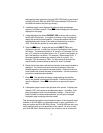
waypoints in the database having the identifier. Below the identifier is a
list of the waypoint types (APT, VOR, NDB, INT, SUP) and the associated
countries which use the identifier. To see an example of a Duplicate
Waypoint page perform the following steps:
• Press D.
• Turn the left inner knob to select the letter D as a waypoint identifier. “D”
is the full identifier of several waypoints in the KLN 90B database.
Press E. The Duplicate Waypoint page will be displayed on the left side
. At the time of this writing, there were ten waypoints in the database
having the identifier “D”. As in this example, if there are more than four
waypoints having the same identifier, only the first four are initially shown.
The list includes an NDB in Canada, an NDB in Cuba, an NDB in the
United States, and an NDB in Libya. The cursor will be over the first way-
point listed. They are listed with the waypoint closest to the aircraft’s pre-
sent position displayed first and the waypoint farthest from the aircraft dis-
played last. To view the rest, rotate the left outer knob clockwise. Doing
so will move the flashing cursor over waypoints two, three, and four and
then will cause the waypoint list to “scroll” so that the other waypoints in
the list may be seen. To select the desired waypoint, move the cursor
over the appropriate choice.
• Press E to view the waypoint page for the selected waypoint.
• Press E to approve the waypoint page.
3.0 INITIALIZATION AND TIME TO FIRST FIX
Since the KLN 90B stores its position and other required parameters in
memory when power to the unit is removed, it is seldom necessary to aid
the unit in reaching a NAV ready condition. The time required from power
on until the KLN 90B determines its present position and is therefore ready
to navigate is called “time to first fix.” The time to first fix is normally a few
minutes or less. In order for the KLN 90B to reach a NAV ready condition, it
is necessary to meet the following conditions:
1. The KLN 90B’s “almanac” data must be current. Almanac data is crude
orbital information for all the satellites and is used for initial acquisition
when the KLN 90B is first turned on. This data is stored in the KLN
90B’s non-volatile memory and is considered current for up to six
months. Each satellite sends almanac data for all satellites. Since the
KLN 90B routinely updates the almanac data during normal operation,
10


















